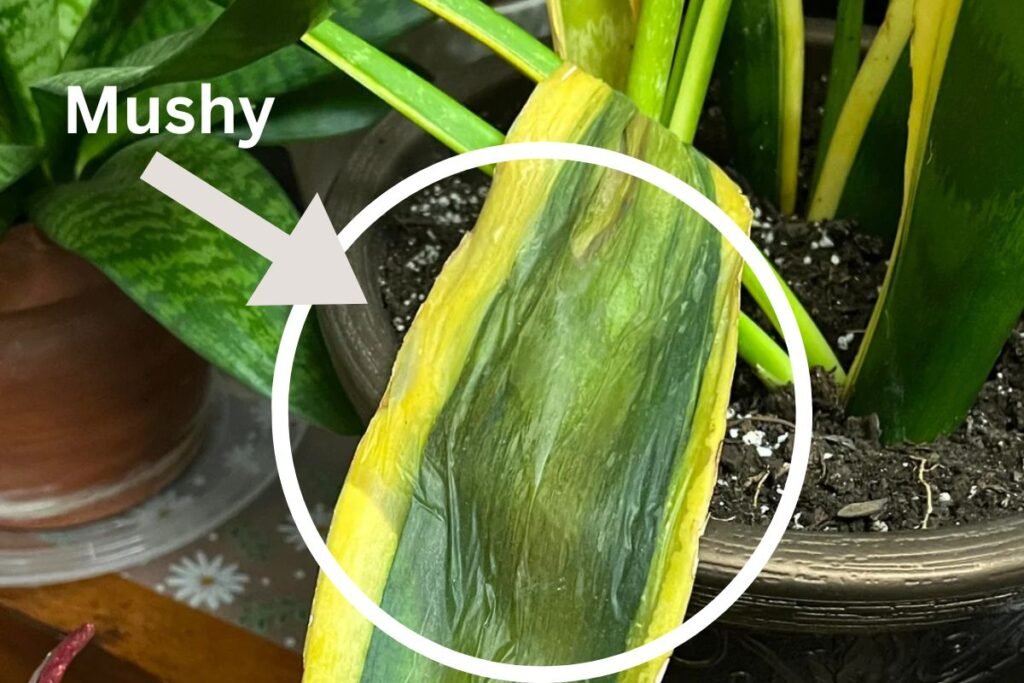Last month, I walked into my living room and noticed something wasn’t right with my favorite snake plant. The normally firm, upright leaves were drooping, and when I touched them – squish! My heart sank. The thick, sturdy leaves that had stood tall for years were now soft and mushy.
If you’re reading this, you’ve likely just had the same heart-dropping moment. You may be wondering, “Is my plant dying?” or “Can I save it?” Take a deep breath. I’ve been exactly where you are, and I want to share what I learned when I faced this issue.
Snake plants (Sansevieria or Dracaena trifasciata) are known for their tough, rigid leaves. When those leaves turn soft and mushy, it’s a clear cry for help. But don’t give up hope! Most snake plants can bounce back with the right care.
Table of Contents
Why Are My Snake Plant Leaves Soft and Mushy?

Let’s talk about what causes this problem. I’ll share what I found in my own plant care journey.
Overwatering: The Number One Culprit
The most common reason for soft, mushy snake plant leaves is too much water. Snake plants are succulents. They store water in their leaves and don’t need frequent watering.
When I first noticed my snake plant’s mushy leaves, I thought back to my watering habits. I had been watering weekly, thinking I was being a good plant parent. But I was actually drowning my poor plant!
Signs your snake plant is overwatered:
- Soft, mushy leaves (often starting at the base)
- Yellowing leaves
- Drooping or falling over
- Foul smell from the soil
- Visible mold on the soil surface
When snake plants sit in too much water, their roots can’t breathe. This leads to root rot, which stops the plant from taking up nutrients. The leaves then become soft as the plant cells break down.
Cold Damage: The Sneaky Culprit
Another reason for mushy leaves is cold damage. Snake plants like warm temps between 70-90°F (21-32°C). When exposed to temps below 50°F (10°C), the water in their leaves can freeze and damage cell walls.
In my case, I had placed my snake plant near a drafty window during winter. The cold air had damaged the leaves without me noticing until they turned soft.
Pest Problems: The Hidden Invaders
Pests can also cause soft leaves. Mealybugs, spider mites, and scale insects suck the sap from the plant, leading to weak, soft leaves.
I’ve dealt with mealybugs on my snake plant before. They look like tiny white cotton balls on the leaves or in leaf joints. Check your plant closely for any signs of these pests.
Fungal or Bacterial Infections: The Silent Spread
Sometimes, infections cause soft, mushy leaves. These often start as small spots that grow and soften the leaf tissue.
I once noticed black spots on my snake plant before the leaves turned mushy. This was a fungal infection that spread quickly before I caught it.
My Personal Solution: The Repotting Method
When I discovered my snake plant’s mushy leaves, I took immediate action. Here’s exactly what I did to save it, which might help you too:
Step 1: Remove from the Original Pot
First, I carefully took my snake plant out of its pot. The soil was soggy and had a sour smell – clear signs of overwatering. Some roots were brown and mushy instead of firm and white.
Step 2: Assess the Damage
I gently removed all the old soil and rinsed the roots under lukewarm water. This helped me see which parts were healthy and which needed to go.
Step 3: Trim Away the Damage
Using clean scissors, I cut away all soft, brown roots. This was tough – I had to remove almost half the root system. I also removed the mushiest leaves by cutting them at the base.
Step 4: Let It Dry
This step is key! I let my snake plant air dry for two days. This helps prevent further rot when repotting.
Step 5: Repot in Well-Draining Soil
I chose a succulent soil mix with extra perlite for better drainage. The new pot had drainage holes – a must for snake plants!
Step 6: Careful Watering Schedule
After replanting, I waited a week before the first watering. This gave any small root wounds time to heal. Now I only water when the soil is completely dry – about every 3-4 weeks.
The Recovery Process: What to Expect
Recovery takes patience. My snake plant didn’t improve overnight, and yours won’t either. Here’s what I noticed during my plant’s healing journey:
Weeks 1-2: The Waiting Game
Nothing seemed to change at first. Some leaves continued to soften and die. This is normal! The plant is focusing energy on root recovery, not leaves.
Weeks 3-4: Signs of Hope
Around week three, I noticed the remaining leaves felt firmer. The color improved too – less yellow, more green.
Month 2: New Growth
After about six weeks, I spotted a tiny new leaf emerging from the soil. This was the most exciting moment! It meant my plant had enough energy to grow again.
Month 3 and Beyond: Full Recovery
Three months after repotting, my snake plant looked like a new plant. Not as full as before, but healthy and growing steadily.
Preventive Care: Stop Mushiness Before It Starts
I learned some valuable lessons from this experience. Here’s how I prevent soft, mushy leaves now:
Proper Watering Techniques
I now water my snake plant only when the soil is completely dry. To check, I stick my finger 2 inches into the soil. If I feel any moisture, I wait longer.
During winter, I water even less – maybe once a month. Snake plants go semi-dormant in cooler months and need very little water.
Light and Temperature Conditions
I moved my snake plant away from drafty windows. It now sits in bright, indirect light where the temperature stays steady. No cold drafts, no direct hot sun – just the way snake plants like it.
Seasonal Care Adjustments
I’ve learned to adjust my care with the seasons:
- Spring/Summer: Slightly more water, feed lightly once a month
- Fall/Winter: Reduced watering, no fertilizer
Soil and Pot Considerations
The right pot and soil make a huge difference. I now use:
- Terracotta pots (they allow soil to dry faster)
- Cactus/succulent soil mixed with extra perlite
- Pots with drainage holes (absolutely essential!)
When to Say Goodbye: Knowing When It’s Too Late
Sometimes, despite our best efforts, a snake plant can’t be saved. Here are signs I’ve learned that indicate it might be time to say goodbye:
- All leaves are soft and falling over
- The base and roots are completely mushy
- There’s a strong rotting smell
- New leaves immediately turn soft and die
- Dark, spreading rot that doesn’t stop after treatment
If your plant shows these signs, it might be kinder to take some healthy cuttings (if any remain) and start fresh.
Common Questions About Soft, Mushy Snake Plant Leaves
Through my plant rescue journey, I’ve heard many questions from other plant parents. Here are answers to some common ones:
Can I cut off just the mushy parts of leaves?
You can try, but in my experience, once a leaf starts turning mushy, the whole leaf usually dies. It’s often better to remove the entire leaf at the base.
Will my snake plant grow new leaves after I cut off the mushy ones?
Yes! If the roots are healthy or recovering, new leaves will grow from the rhizome beneath the soil. This can take time – be patient.
How long does it take for a snake plant to recover?
From my experience, expect at least 2-3 months for visible improvement. Full recovery might take 6 months or longer, depending on how severe the damage was.
Can I use hydrogen peroxide to treat root rot?
Yes, this can help. After removing the plant from its old soil, you can soak the roots in a solution of 1 part 3% hydrogen peroxide to 2 parts water for about 30 minutes. This helps kill harmful bacteria. I’ve tried this method with good results.
Should I put my recovering snake plant in direct sunlight to help it dry out?
No! Direct sun can stress an already weak plant. Bright, indirect light is best for recovery.
My Top Tips for Healthy Snake Plants
After nursing my snake plant back to health, I’ve developed some go-to rules for keeping it happy:
- Water deeply but infrequently – when in doubt, wait longer
- Feel the soil before watering – it should be completely dry
- Use a pot with drainage holes – always!
- Choose proper soil – regular potting soil is too dense
- Watch for early warning signs – slight yellowing or softening
- Keep away from cold drafts and hot, direct sun
- Clean the leaves occasionally to remove dust
The Emotional Side of Plant Rescue
Let’s be honest – seeing your snake plant with soft, mushy leaves can be upsetting. These plants often have special meaning to us. My snake plant was a gift from my grandmother, so I felt real sadness when it started declining.
If you’re feeling bad about your struggling plant, know that it’s normal. We form bonds with our plants. They bring life and beauty to our homes. Trying to save them isn’t just about the plant – it’s about preserving something that matters to us.
Celebrating Success: My Snake Plant Today
I’m happy to report that my snake plant not only survived but is now thriving. The leaves stand tall and firm, with that gorgeous deep green color and yellow edges. It’s even produced two “pups” (baby plants) that I’ve shared with friends.
When I look at my healthy snake plant now, I feel a sense of accomplishment. We went through a rough patch, but with the right care and patience, recovery was possible.
Final Thoughts: The Resilience of Snake Plants
If there’s one thing I’ve learned from this experience, it’s that snake plants are amazingly tough. Even when they look nearly dead, they often have the strength to bounce back.
So if you’re staring at your soft, mushy snake plant feeling hopeless – don’t give up yet. Try the steps I’ve outlined. Be patient and consistent. Your plant might surprise you with its will to live!
Remember, repotting in well-draining soil made for succulents was the key to saving my plant. Combined with a careful watering schedule, this gave my snake plant the fresh start it needed.
Have you dealt with soft, mushy snake plant leaves? What worked for you? I’d love to hear your stories in the comments below. We plant lovers can learn so much from each other’s experiences!
Happy growing!
My name is Shahriar Robin, and my journey with plants began in childhood, igniting a lifelong passion that blossomed alongside my career as a nutritionist and sports trainer. Through SnakePlant.org, I channel this dedication, merging expertise from nutrition and sports training to nurture a platform sharing all-encompassing knowledge about Snake plants. This website mirrors my commitment to cultivating greenery, offering comprehensive insights on growth, maintenance, and nurturing practices for these captivating plants. My mission is rooted in leveraging diverse expertise to enhance plant care practices, believing profoundly in the therapeutic impact of nature. Join me on SnakePlant.org, where I unite a thriving community of enthusiasts, sharing experiences, insights, and the profound joys of planting.

